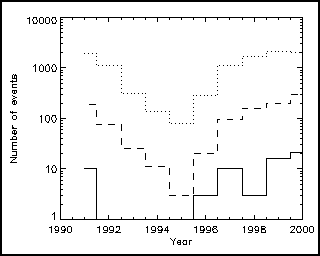
|

|
When do powerful flares occur?
By way of background, the distribution function of total flare energies has been well studied. A distribution function represents the frequency at which events occur, distributed over some parameter: in our application, it is the total flare energy as represented by its soft X-ray peak flux. This is a power-law distribution over the observable range, almost an inverse-square law, such that there are roughly 1/10 as many events of 10 times the total energy. This is the solar equivalent of the astronomer's log-N/log-S curve, for those interested in something entirely different (the example linked here is for cosmic gamma-ray bursts, but stars, galaxies, quasars, etc., all have their intrinsic occurrence distributions).

|

|
Now for the key question. Look at the year 1998 in the upper panel: only three X-class flares occurred, but an amazing 161 M-class flares popped off. This epoch, plus 1993 (with no X-class flares, plus the recent RHESSI epoch with one X-class flare and 45 M-class flares, seem different. The average ratio of X to M for the entire epoch (not counting RHESSI's 2002 experience) is 1:17 or so, so that a naive view of the statistics would say that we could multiply M-flare numbers by 0.059 +- 0.007 to get predicted X-flare numbers. Hence the table below for the odd epochs:
| Interesting epoch | X-flares predicted | X-flares observed |
| 1993 | 4.4 +- 0.5 | 0 |
| 1998 | 9.4 +- 1.3 | 3 |
| Early 2002 | 2.6 +- 0.3 | 1 |
The above table, depending upon whether you are an optimist or a pessimist, provides convincing evidence of a changing distribution function, or not. The red entries refer to the RHESSI epoch, which lay outside the ten-year Yohkoh interval used for the predictions. In the latter case the skeptic would just shrug and say that there are too few events to deal with statistically. The author of this nugget would disagree with that sort of skeptic, though. In terms of the primitive view of the statistics presented here, the 1998 result is a "three-sigma" result, of which we can be confident at the 99% level. In a horse race this would be a very good bet indeed. The simple approach works better for the RHESSI epoch, but any interested reader is invited to apply some fancypants technique such as a Kolmogorov-Smirnov test, which I am sure would be decisive. Ask if you want detailed lists of flare magnitudes.
Meanwhile, here is another look at the statistics, the time variation of the X/M count ratio with primitive error bars. The 1998 epoch stands out clearly (but note 1996, where a single X-class flare occurred, and only 3 M-class flare):

Well, this has been a dull nugget because there have been no pretty pictures, so here is a pre-flare view of the X-class flare of July 7, 1996:

The flare occurred in the right-hand region. It is only interesting in this context (since Yohkoh missed the main part of it) because it was the unique X-class flare during solar minimum. In 1996 only 3 M-class flares occurred, plus this X-class one. So... is this an example of another distortion of the flare distribution, ie a time when there was a deficit of middle-sized flares and not great flares?
May 3, 2002
Hugh Hudson (hudson@isass1.solar.isas.ac.jp)